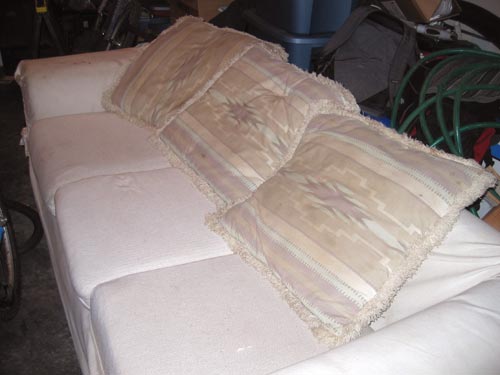That’s it. I will make good on existing commitments, but I am totally over web design. I’m done. No more.
I quit.
Let me explain. Last September, I wanted nothing more but to work in the web design industry. To that end, I spent my fall covering the world with resumes, and I never heard a single response. Not one. Convinced that I was pursuing a dead end, I shifted the entire focus of my life and became a snowboard instructor instead. Fate never gives you what you want when you look her straight in the eye, but if you dance around the subject long enough you’re bound to end up with what you want. Or what you deserve.
In January I picked up a job working as, of all things, a web designer. It was one of those things in life that catches you completely by surprise and kicks you in the gut. You’re coasting along in one vein, convinced that you have a pretty good idea how the next season of your life is going to play out, and suddenly everything changes shape. You spend the entire autumn scampering around for a rake, and when you’ve all but given up the search you take one more step, and it flies up and hits you in the face.
That’s what this job was. I had all but sworn off my dreams of becoming a real web designer, when all of a sudden along comes the perfect opportunity. In the past eleven months I’ve probably built thirty websites. Every one is different. Some are better than others. Some more attractive than others. Every one embraces the web standards approach.
When I arrived on the team, the company I worked for had no standards for how it implemented a website. You see, when I say I’ve built a couple websites, I mean quite literally that I built a couple websites. I didn’t design them. The designers do that. I didn’t program them. Our scripters do that.
What my job has been (at least, after I crawled out of software support hell) for the last eleven months is something one might call design implementation. I take the beautiful Photoshop comps that our contracted designers cooked up, and I make them work as a website. I don’t have input on the creative aspects of the design, but I am responsible for reining in the designers when they create something foolhardy and wholly dysfunctional for the web.
I tweak certain aspects of the design so they work with our content management system. I do massive amounts of project management and modest amounts of information architecting. In the process, I have developed a set of robust standards-based HTML templates, a la CSS Zen Garden, where I can graft on just about any design using pure CSS code.
The sheer amount of knowledge I needed to possess to reach this point is mind-boggling. I have internalized every common browser quirk known to mankind, to the point where they become completely invisible in my designs. The reason I rarely use browser hacks is not because I don’t know them, but because I write my code in such a way that I can sidestep hacking situations altogether.
Whitespace parsing errors, duplicate character errors, child selector filters, star hacks, escape character hacks, box model hacks, image replacement techniques… some of these are things that are so new or so esoteric that you won’t find them in any book on web design. In some industries that would be considered bleeding edge, where techniques are so new that they’re not even documented. In standards-based web design, however, word travels fast. Anything that blazed through design weblogs a month ago is now old news.
We make it look simple. As web designers, it’s our job to make it look simple. While I have been building websites for nearly four years, my professional career as a web designer has lasted only eleven months. In the process, I’ve probably learned enough tricks, techniques, hacks and philosophies to fill five books on the subject.
And now I could really care less. The change hit me about three months ago. It was at that point I became able to implement any contracted design, for any client website, without tables. When that happened, it felt like all the air had been sucked out of my passion for the sport. Validating in an XHTML Strict environment wasn’t a problem. I had mastered just about every CSS technique I would ever need. I had mastered XHTML/CSS, so the next logical step was to start on adopting new skills. I set out to learn Linux, PHP, MySQL and JavaScript. I grabbed a stack of O’Reilly books and started digging in, ready to learn something new.
What I actually learned surprised me. I found that I had no interest whatsoever in picking up these skills. The books didn’t fill the void left by the mastery of XHTML/CSS. I was shocked when I came to the realization that this was not the direction I wanted to go. Shocked. What was up with that? I have an endless thirst for knowledge, and I had only mastered a small fraction of the world that makes the internet work.
What did I feel I had to lose in learning these new skills? A better understanding of scripting, hosting and databases would go a long ways in making me a better web designer. Didn’t I thirst for continual growth? Why the sudden resistance?
And then, I knew. I remembered. I never got into web design as an end. I don’t enjoy websites for the sake of websites, computers for the sake of computers, or code for the sake of code. I got into web design one cold January night in 2001. I had a crisis of faith regarding my major in jazz studies, which set forth a chain of events that resulted in my becoming a writer. I needed a place to quickly and easily publish my thoughts, so in February I started a website named Cromlech.
I wanted a website not because I wanted a website, but because I wanted a place to publish my thoughts. I taught myself web design not because I wanted to learn web design, but because I found that the knowledge made it easier for me to manage my writings. I studied web standards not because I wanted to sleep with the King, but because the approach saved me time and agony, and because I strongly believe in the standards-based philosophy.
Web design has always been the means, and I never should have allowed it to become the end. In hindsight, I am glad that I chose this path, or else I may never have recognised the path that I wanted to take in the first place. I should have realized that something wasn’t right when the means began to consume nine of my precious hours a day, five of my precious days a week. My coding skills grew incredibly quickly under those conditions, and I can only hope that I can find a similarly intense environment for honing skills that I value more than web design.
I will quit web design now. I will start wilderness training in June. I will continue writing always.




